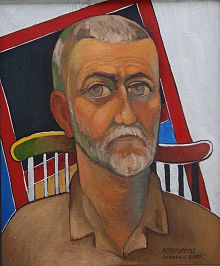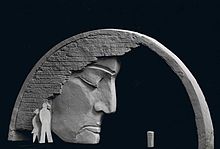Spartak Babajan
Spartak Chatschaturowitsch Babajan ( Russian Спартак Хачатурович Бабаян , English Spartak Babayan , born September 25, 1933 in Armavir , Armenian SSR , Soviet Union ) is a sculptor and painter and one of the main representatives of the post-Soviet painters of perestroika . As an expressionist, he was best known for his “urban landscapes”. In the later Californian creative phase through a harmonious synthesis of cubist and figurative elements in his pictorial compositions. He was influenced by the French avant-garde artists Auguste Rodin , Henri Matisse and Pablo Picasso .
Life
Training and early work
From 1955 to 1962 Babajan graduated from the Terlemesjan Art School in Yerevan with a focus on sculpture . In 1962 he continued his studies at the Leningrad Mukhina continued -Kunsthochschule which early 20th century by the Russian vanguards of Kasimir Malevich was founded. He successfully completed his studies in sculpture, painting and architecture in 1967 and returned to his homeland, Armenia. There and in other southern Union republics of the former Soviet Union, the sculptor worked for many years on the realization of state art commissions, which resulted in a large number of monuments and sculptures in the region.
The art style for his work, naturalism and realism, was given to Babajan by the client through the theme. With the majority of his works as a sculptor, his ambitions and inspirations as a modern artist almost always fell by the wayside. Exceptions include the monument to the mathematician "Al-Chorisme" in Khiva ( Uzbekistan ), which shows his artistic potential as a sculptor of modernism.
Moscow time
In 1984 Spartak Babajan and his family moved to the capital Moscow. With perestroika came the political opening of the Soviet Union and new freedoms for artists arose. Babajan now devoted himself to modern painting. Spartak Babajan revealed himself as a neo-expressionist among the painters of perestroika.
Creative phase in Germany
Due to the political opening of the Soviet Union, his popularity also grew in Western Europe. There Babajan became known as the "painter of perestroika". As such, he opened his first own exhibition in Berlin in January 1991 together with his daughter Yvetta. Others followed in Greece, Italy, Germany and Switzerland.
Between 1995 and 2003, the sculptor Babajan took part in several art competitions in Berlin to design historical personalities. The first competition was about the "Captain von Köpenick" as a life-size bronze figure on the steps of the town hall in Berlin-Köpenick. Spartak Babajan won the competition and implemented the project in cooperation with the Seiler foundry from Schöneiche near Berlin. A second tender was about the restoration of the monument to Frederick the Great, which disappeared in 1945, from the market square in Berlin-Friedrichshagen. Spartak Babajan designed the figure of "Old Fritz" in life size and on a pedestal.
Relocation to California
In 2002 the artist followed his family from Moscow to Ontario , where his son Armen in 1991, his wife Galina and daughter Yvetta in 1996 had already found a new home. During his first years in America, Babajan took up his previous preferred painting styles and motifs from the Moscow perestroika period in a retrospective. He supplemented his picture compositions with figurative elements or abstract expressionist forms. He gained further fame through regular participation in the most important exhibitions as a modern artist in New York, San Francisco, Los Angeles and others.
Work as a sculptor and painter
Early work as a sculptor
Spartak Babajan was selected as a sculptor by the Art Association of the USSR for a number of post-war art projects for monument projects and monuments to be realized in Moscow and the southern Union Republics. In the 1970s and 1980s, in addition to the large monuments in various cities and regions, smaller monuments, reliefs and statues were created in the Soviet Union, which were created by the artist Spartak Babajan. They were intended to remember the Red Army soldiers who were killed in action against the German Wehrmacht . These memorials are not only memorials to the victory over Germany, but also Soviet war cemeteries. Spartak Babajan's father was also a victim of the German attack in the first days of the Second World War .
- Creative phase in Germany
- 1996: Monument "Captain von Köpenick" (City Hall Köpenick)
- 1997: Order from the city of Frankfurt (Oder) for a model of the “Historic Postilion” monument that was destroyed in the Second World War (remained unrealized). Spartak Babajan won and realized a monument to restore the monument to Frederick the Great.
- 2003: Monument "Friedrich II." (Berlin-Friedrichshagen)
Contemporary work as a painter
Towards the end of his Moscow “perestroika phase”, his compositions turned from analytical to synthetic Cubism. In the first years of his creative period in California, Babajan took up his previous preferred painting styles and motifs from the perestroika period in a retrospective. He supplemented his picture compositions with figurative elements or abstract expressionist forms. In his creative phase from 2010 onwards, the Armenian-Russian neo-expressionist Babajan crowns his artistic form of expression with figurative-decorative design elements that are reminiscent of the French avant-garde of the last century Henry Matisse.
reception
A. Lukaschow (Moscow / Tretyakov Gallery, Russian art critic 1992): “Mysticism and mysteriousness did not emerge as visible forms on the basis of the artist's experiences. They emerged in the subconscious of the artistic creative process as a sign of the immortal, in the knowledge of the multidimensional world, and that what is visible on the artist's canvas is only a reflection, a mirror image of his soul. A remarkable balance between reality and subjectivity can be seen in Spartak Babayan's pictures. "
Dr. W. Gerber (Berlin / Galerie “Fliegende Reiter”, art critic 2013): “The mental mood or the mental state determine the artist's creative process. In the pictures of Spartak Babayan this state is realized through his mediality and improvisational art. The mediality determines the content of the composition from the artist's nostalgic immersion, from the impressions of his past - reproduced and united in one picture from Armenia, Central Asia, Russia, Western Europe and ultimately California, the new home of his family - connected like a permeated refrain through great melancholy, intimacy and heartfelt desires that live in the artist's feelings. "
Web links
| personal data | |
|---|---|
| SURNAME | Babajan, Spartak |
| ALTERNATIVE NAMES | Бабаян, Спартак Хачатурович Бабаян; Babajan, Spartak Chatschaturowitsch (Russian); Babayan, Spartak (English) |
| BRIEF DESCRIPTION | Armenian sculptor and painter |
| DATE OF BIRTH | September 25, 1933 |
| PLACE OF BIRTH | Armavir , Armenian SSR , Soviet Union |



